

12 Best Client Collaboration Software Tools to Cooperate with Customers in 2024
When setting up roots within your niche, keeping things simple and traditional often seems like the best way to go. Collaboration with clients is easiest when you talk to them directly, over the phone, or through simple tools such as email, is it not?
While staying on top of customer conversations using these “simple” methods might be easier initially, as soon as you start attracting a larger customer base, you’ll have to start looking into collaboration solutions that can simplify processes.
Client collaboration software is designed to be your go-to communication channel, enabling you to have a seamless back-and-forth with your customers. However, whether it proves to be helpful or just another inconvenience for businesses depends on the tool chosen.
Take a look below to learn more about client collaboration tools and find a detailed comparison of some of the best ones available, then take your pick.
What is client collaboration software?
A customer collaboration platform is a comprehensive communication solution that helps you keep all customer conversations in a single, organized space. Most commonly, it’s a cloud-based tool (though some also come with a handy mobile app) that allows for a seamless exchange of information between your teams and your customers.
Using reliable customer collaboration software, your teams will always have access to the entire conversation history – from the moment your customers make their first request to the very last interaction you’ve had with them.
Moreover, with cloud-based file sharing, your entire team and your every customer will have access to all the relevant documents and paperwork that make your relationship all the more lucrative. You can use the client collaboration platform to send all the essential onboarding paperwork, comprehensive project plans, insightful reports, project deliverables, etc.
The ultimate goal of customer collaboration tools is to simplify communication, eliminate misunderstandings, and streamline project management. Therefore, you’ll have access to all the valuable collaborative features that enable you to achieve that goal.
The importance of client collaboration tools
With the help of a customer collaboration portal, you can keep your business competitive, productive, and efficient. Just like you could use tools like Scrum for your daily standup meetings for improved team collaboration, you can use customer collaboration platforms for improved collaboration and communication with your customers.
Sticking to the traditional methods of customer interaction – emails, phone calls, and messages – presents numerous problems that could easily be avoided.
You’ll be more at risk of overlooking important details, which will negatively affect the customer experience. You’ll find it difficult to keep track of all the key account data. Your email threads, messages on diverse platforms, phone conversations, and more will make finding any relevant project information challenging, if not impossible.
Therefore, if you want you and your project managers, executive teams, and customers to stay on the same page and keep all communication clear, concise, and transparent, you’ll need reliable customer collaboration software packed with valuable collaboration features.
The most common challenges in client collaboration software
Despite client collaboration tools being lauded for all the useful features they provide access to, they are not without their faults. Even the best customer collaboration platform will come with some common challenges that can impact customer satisfaction.
Most commonly, the biggest obstacle is customers refusing to start using the collaboration tool in question. Depending on your unique niche and the types of clients you frequently work with, you’ll find that many of them often have countless tools and software they already rely on. Joining and learning how to use a new platform might be too much hassle for them.
Another common issue is the improper use of the tool. In many instances, teams new to client collaboration software will simultaneously try to use this tool and numerous other unconnected channels with customers.
They could start sharing important files via email instead of via the tool, communicate via social media accounts, schedule meetings via video-conferencing tools, and more – despite the best online collaboration tools having all the key features needed.
How client collaboration software addresses the challenges
Whether client collaboration software will address the challenges above and how it will do it will depend entirely on the software in question.
The top customer collaboration platforms that want happy clients typically have a long list of powerful features and capabilities that can quickly address common challenges.
If your client is already a user of many different platforms and software and refuses to sign up on a new platform, many solutions that facilitate communication between clients and teams will offer useful APIs.
With the help of an API, the client portal can be integrated with any existing solutions you or your customer may already be using. It makes transitioning to a new tool easier without having to brace the learning curve or change your existing habits.
The problem of the improper use of the tool, on the other hand, is easily avoided with tools with extensive customer onboarding programs.
Most modern solutions have an intuitive interface and are exceptionally easy to navigate. However, it’s still vital for you, as the business owner or the customer collaboration manager, and your entire team to go through extensive onboarding to familiarize yourself with the solution and learn how to use all the advanced features.
Features of client collaboration tools
Although every client collaboration software is a purpose-built tool with somewhat unique capabilities, there’s still an extensive list of basic features you should expect to have, regardless of the specific solution you choose.
As a general rule of thumb, the following are some of the key features you should look for:
- 📂 Seamless file sharing – for seamless collaboration, you need the option to share files seamlessly. Most tools will offer automatic file sharing, enabling you to send all relevant documents, files, and more without wasting any time;
- 💬 An array of communication tools – for efficient collaboration, most tools will have communication features such as instant messaging and two-way messaging, real-time videos, screen sharing, and more;
- 🔗 Valuable integrations – as mentioned, most tools will come with valuable API and integrations with some of the most popular platforms that you and your customers may already be using;
- 🔒 Custom user permissions – you can restrict access to files, set unique permissions, prevent unauthorized access, and curate what data your customers and your teams have access to;
- 🛡️ Cutting-edge security – of course, the best collaboration platforms will boast comprehensive security features that will ensure your and your clients’ sensitive information remains protected at all times.
Remember that these are just the basic features of most client collaboration tools. Depending on the tool you choose, you’ll likely gain access to countless additional features such as time tracking and billable minute tracking, project tracking and real time feedback, document management, and more.
Benefits of customer collaboration platform
Relying on a powerful customer collaboration platform offers an array of benefits for you, your teams, and your customers. Some of the main benefits are as follows.
Increased transparency
With everyone within the organization, including business owners, sales reps, creative teams, project managers, and customers, having access to all the relevant documents, the latest versions of files, previous interactions, and more on a single platform, it becomes much easier to maintain a higher level of transparency.
Everyone included in the client projects will have all the information they need at any given time, making it easier to notice potential issues and bottlenecks before it’s too late.
Easier project planning
With everyone on the same page and instant access to all relevant data, even the most complex project becomes significantly easier to plan.
Your teams won’t need a constant and often confusing back-and-forth with the clients. They won’t have to search through different platforms to find previous conversations or dig through piles of paperwork to locate the needed documents. They’ll have everything they need in a unified platform, meaning that your projects will go as smoothly as possible.
Time and cost efficiency
With clear, transparent communication and simplified project planning, you won’t have to waste time and money back-tracking your steps or trying to identify problems that could’ve been solved had they been caught earlier.
You’ll minimize misunderstandings and miscommunication, ensuring that your projects are completed exactly to the customer’s specifications.
Better customer retention
Perhaps the greatest benefit of using an external tool like client collaboration software with the best AI chatbots is that it helps you improve your customer retention.
Retention rates can vary significantly across industries, but increasing them should always be your main objective regardless of your niche.
AI chatbots enhance customer interactions by improving communication and ensuring the utmost transparency during every interaction with both your extremely high-value accounts and lower-value ones, you can improve customer satisfaction, boost loyalty, and get your retention rates sky-high.
How to choose the best customer collaboration tools for managing clients
Client collaboration tools come in all shapes and sizes, making it difficult to discern which is the best option for you and your teams. To avoid investing in a potentially less effective tool, you’ll want to keep an eye on several factors when making your decision:
- User-friendly interface
While most solutions will offer extensive onboarding for your teams and clients, you’ll still want to look into those that have a clean, user-friendly interface and are easy to navigate and get used to. If the learning curve is too high, neither your customers nor your teams will want to use the platform.
- Advanced collaboration tools
Client collaboration on complex projects requires completely streamlined communication. Therefore, you’ll want software with real-time communication capabilities, reporting features, individual and group messaging, video conferences, and more.
- High-level security
You’ll want a secure client portal that can ensure that your and your client’s sensitive data is always kept safe. Moreover, you’ll want a portal with extensive authorization options, secure file sharing, role-based permissions, and more.
- Easy scalability
Above all else, you’ll want a versatile tool that can grow together with you. You’ll want a tool that enables you to upgrade anytime or even downgrade as needed.
- Budget-friendly
Of course, you’ll also want to keep your budget in mind when selecting the right collaborative customer relationship management platform. Not all the best tools are the most expensive, nor are all the worst ones the cheapest. Look for affordable solutions that deliver quality.
12 best client collaboration software
If you want to create a collaborative environment, ensure that your customers feel heard, and reap all the benefits of customer collaboration, check out the following client collaboration software that’s bound to check all your boxes.
1. Ayanza

Best for real-time collaboration.
Ayanzais a comprehensive plug-and-play solution that simplifies every process – from administrative task allocation to task management and customer collaboration.
With real-time collaboration being its key feature, it ensures that everyone within your organization has the tools to keep communication clear, concise, and transparent.
✨ Features
As one of the best-recognized online collaboration tools, its other notable features include:
- Team allocation;
- Time tracking;
- Task dependencies tracking;
- Project completion monitoring;
- AI-powered collaboration.
**➕
Pros**
- Flexible and scalable;
- AI-powered predictive maintenance;
- Fully customizable.
➖ Cons
- Free version up to 5 users;
- Getting accustomed to all the features can take a while.
💸 Pricing
If you’re interested in investing in Ayanza, you’ll be glad to know that it offers several different pricing plans designed to suit different teams and customers:
- Free – up to 5 users;
- Pro – $6 per user/per month;
- Ultra – $15 per user/per month;
- Enterprise – custom pricing.
2. Workzone

Best for secure file sharing.
Workzone is primarily a project management tool, but it works wonders as a centralized platform for customer collaboration. It boasts a wide array of collaborative features with advanced tracking and reporting.
It comes with mobile apps for Android and iOS, making it easy to gather real-time feedback, access client collaboration history, and perform task assignments on the go.
✨ Features
As a project management platform, it has countless useful features that help you ensure customer success:
- Branded client portal;
- Customizable project dashboards;
- Comprehensive role-based permissions;
- Insightful Gantt charts;
- Shared calendars.
**➕
Pros**
- Comprehensive onboarding process;
- Lightweight;
- Valuable API.
➖ Cons
- Expensive compared to other popular tools;
- Difficult to navigate.
💸 Pricing
Workzone has three pricing plans that you can choose from, depending on the size of your team:
- Team – $24 per user/per month;
- Professional – $34 per user/per month;
- Enterprise – custom pricing.
Workzone has no free trial, but you can always schedule a demo to familiarize yourself with all its advanced features.
3. Teamwork

Best for creative teams.
Although quite feature-packed, Teamwork is a surprisingly easy project management software to navigate.
It’s the ideal platform for improving your customer relationship management process as it comes with a comprehensive client onboarding solution with everything you need to keep your clients engaged.
✨ Features
Some of its most notable features include:
- Customer feedback collection;
- Customizable template creation;
- Social media post calendar;
- Automation features;
- Workload resource management.
**➕
Pros**
- Intuitive interface;
- Affordable plans;
- Advanced customization options.
➖ Cons
- The best features are only available with pricier plans;
- Can become slow with heavier files and documents.
💸 Pricing
Teamwork is a seamless solution with several pricing plans you could choose from:
- Free Forever – up to 5 users;
- Starter – $5.99 per user/per month;
- Deliver – $9.99 per user/per month;
- Grow – $19.99 per user/per month;
- Scale – custom pricing.
To unlock more advanced features like automation, custom template and form creation, and more, you’ll need to upgrade to at least the Deliver plan.
4. Trello
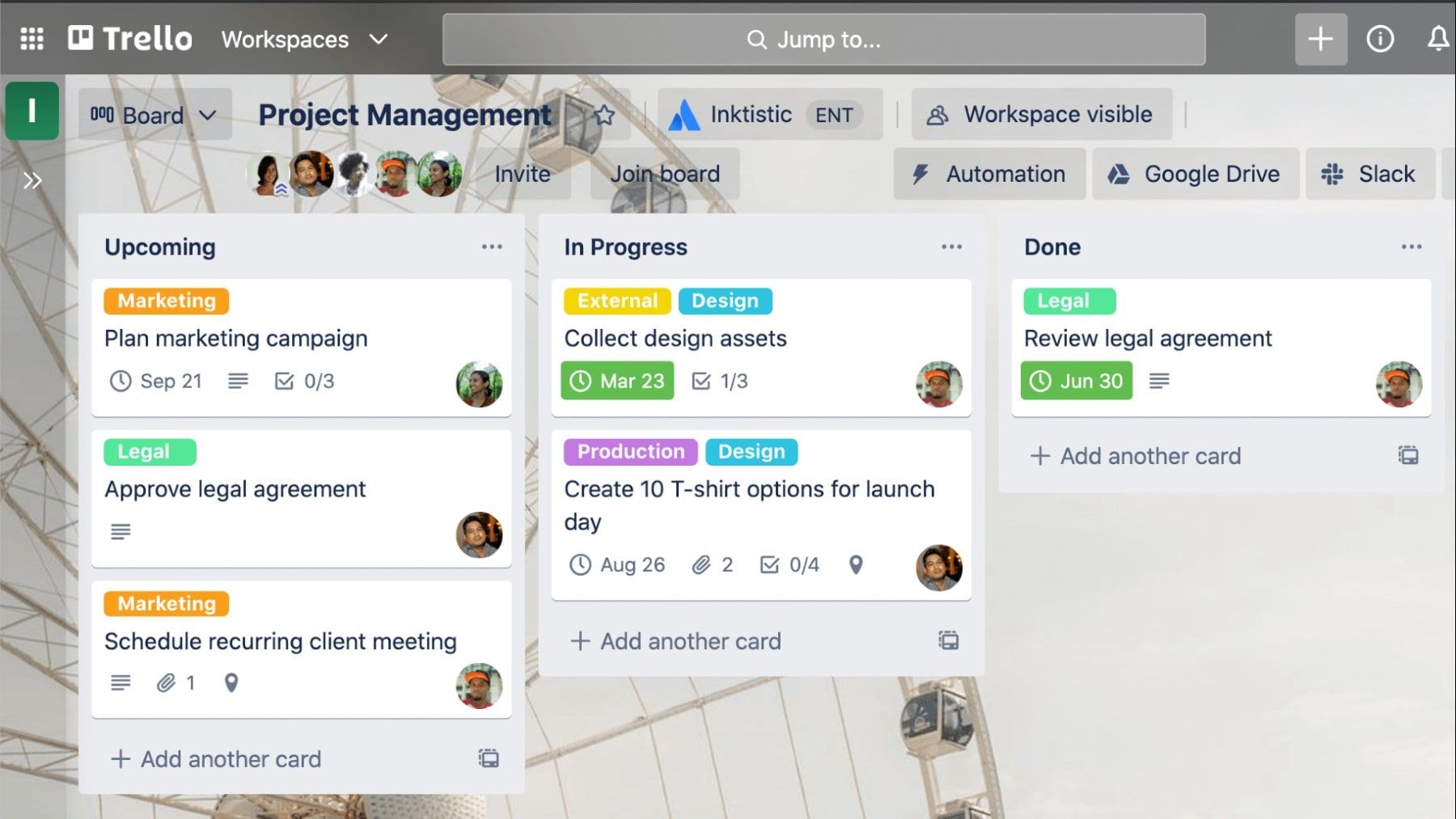
Best for smaller teams and startups.
Trello is perhaps one of the better-known project management tools. It’s known for its simplicity, ease of use, and somewhat surprisingly powerful automation features.
You can use Trello as an AI project manager to easily monitor project progress, add or remove users on projects, automate workflows, and, of course, build a strong relationship with every single one of your customers.
✨ Features
Its top features include:
- Actionable insights;
- Power-ups integrations;
- Workflow automation;
- Trello boards project organization;
- Custom templates.
**➕
Pros**
- Boasts virtually no learning curve;
- Lightweight and easy to use;
- Flexible.
➖ Cons
- No built-in reporting/analytics;
- Many paid add-ons.
💸 Pricing
If you want to start using Trello, you’ll need to sign up for one of its plans:
- Free – for the whole team;
- Standard – $5 per user/per month;
- Premium – $10 per user/per month;
- Enterprise – $17.50 per user/per month.
The Free and Standard plans are somewhat limited, especially if you have a larger team. To get the most out of Trello, you should at least sign up for a Premium account.
5. ClickUp
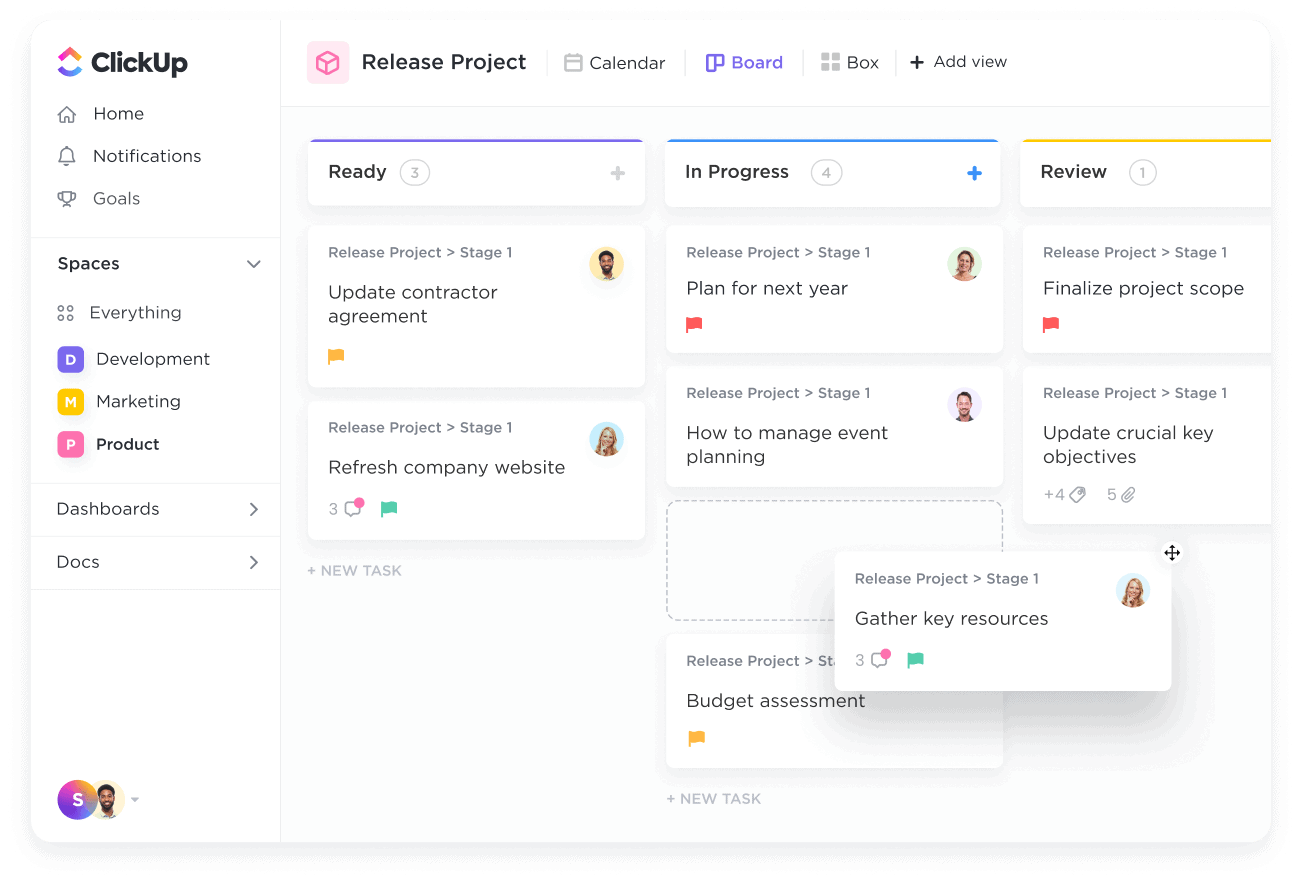
Best for increasing productivity.
ClickUp is an amalgamation of several different tools in one. It’s an online meeting tool, a collaboration platform, and a Customer Relationship Management solution (CRM). It’s feature-packed and powerful, ideal for teams that need to increase their productivity levels.
While it can be a bit more difficult to adjust to, ClickUp offers high quality for an affordable price, making it a popular solution for building online customer communities. If you’re interested in the best Clickup alternatives , you should look into Ayanza.
✨ Features
ClickUp’s main features include:
- Monitoring sales pipeline and account engagement;
- Integrations with email marketing systems;
- AI-powered automation;
- ClickUp Whiteboards for team and client collaboration;
- Real-time updates.
**➕
Pros**
- Excellent customization capabilities;
- Insightful reports;
- Generous free version.
➖ Cons
- Very steep learning curve;
- Mobile apps can be buggy.
💸 Pricing
If you’re interested in giving ClickUp a try, you’ll be able to choose from several different pricing plans:
- Free – for personal use;
- Unlimited – $7 per user/per month;
- Business – $12 per user/per month;
- Enterprise – custom pricing.
The Unlimited plan can be adequate for smaller teams, but the Business plan will get you the best bang for your buck.
6. Aligned

Best for sales teams.
Aligned presents itself as a digital sales room. It’s a powerful platform where your teams and clients can enjoy collaborating, document sharing, gaining insights into deals, joining meetings, etc.
Within minutes, you can create a full-blown customer workspace that will eliminate the need for a constant back-and-forth with your clients, non-stop follow-up emails, and unreturned phone calls.
✨ Features
Some of the key features that come with Aligned include:
- Engagement tracking;
- Deal loss prevention;
- Room analytics;
- Content management;
- Content creator.
**➕
Pros**
- Easy setup;
- Responsive support teams;
- Useful CRM integrations.
➖ Cons
- Lack of customization options;
- Not as feature-rich as some other solutions.
💸 Pricing
Aligned offers several pricing plans designed to suit teams of different sizes:
- Starter – free for up to 3 users;
- Basic – $29 per user/per month;
- Pro – $49 per user/per month;
- Enterprise – custom pricing.
There’s no free trial, but you can always book a demo and learn more about what Aligned has to offer.
7. Monday.com
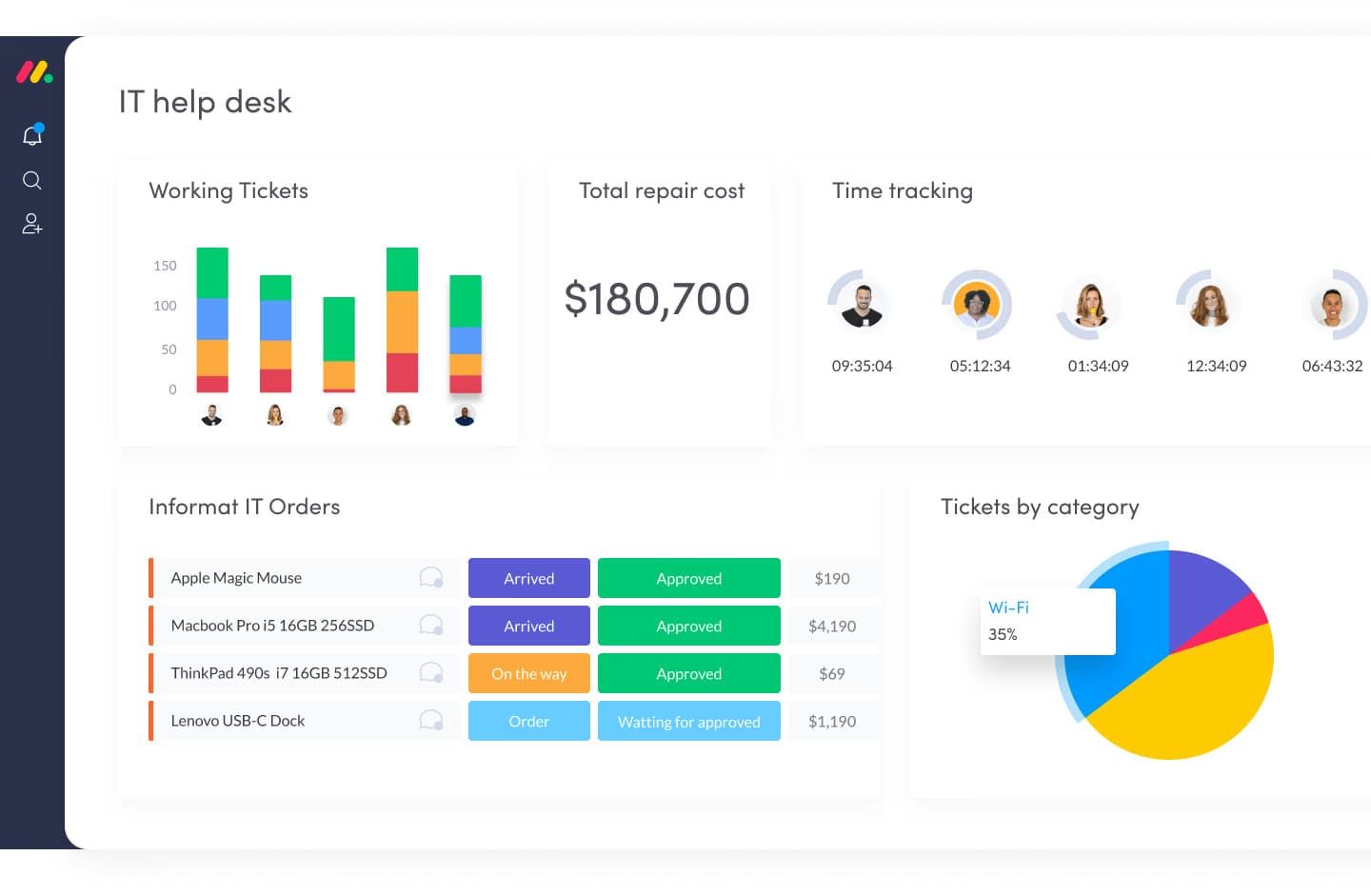
Best for project planning.
Monday creates an authentic team environment for both your employees and your clients. It’s an all-inclusive platform that allows for true customer collaboration with seamless email integrations, interaction tracking, customizable email template creation, and more.
From helping you perfect your sales pipeline to improving your lead capturing and management, Monday has everything you need to ensure success.
✨ Features
Some of the more notable features you can enjoy with Monday include:
- Custom dashboards;
- Automated sales processes;
- Instant overview of the entire deal;
- 360° view of all accounts;
- Extensive client onboarding.
**➕
Pros**
- Countless valuable integrations;
- Top-notch support;
- Fully customizable.
➖ Cons
- Automation features can glitch;
- Editing notification preferences can be problematic.
💸 Pricing
Monday is a scalable solution with plenty of pricing plans designed to suit teams of different sizes:
- Free – for up to 2 users;
- Basic – $8 per user/per month;
- Standard – $10 per user/per month;
- Pro – $16 per user/per month;
- Enterprise – custom pricing.
You can always contact Monday for a limited free trial and familiarize yourself with its full capabilities.
8. SmartTask
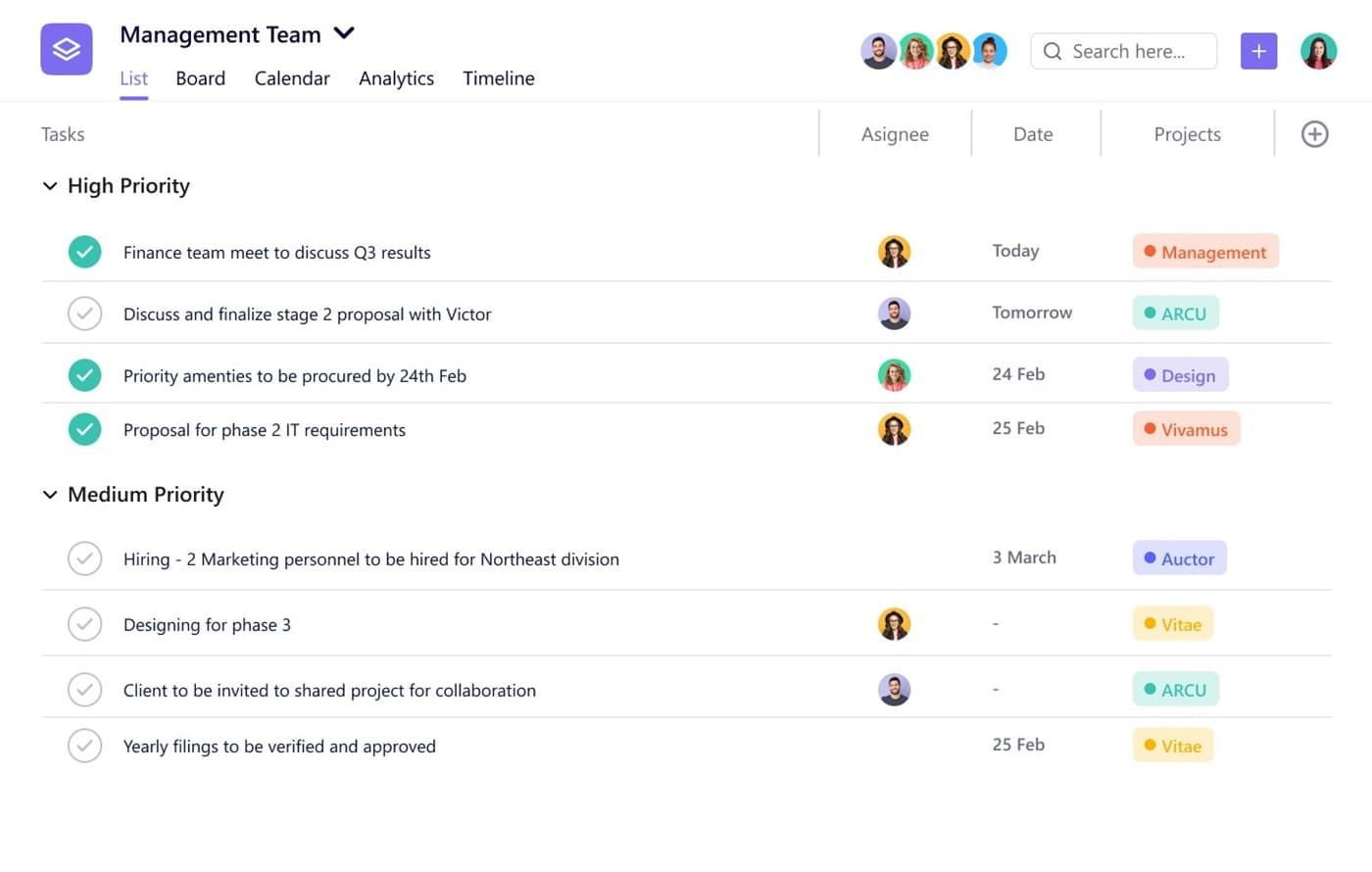
Best for project managers.
SmartTask, as its name might suggest, is primarily a task manager solution designed to make task allocation easier. However, its client portal has proven to be a powerful tool that can help you ensure customer success.
You can use it to track customer behavior, collect valuable insights to improve retention rates, and completely simplify client collaboration.
✨ Features
The most valuable features you’ll encounter with SmartTask include:
- Real-time insights;
- Intuitive dashboards;
- Custom field tracking;
- Smart project templates;
- Integrations with popular tools.
**➕
Pros**
- Generous free version;
- Excellent reporting;
- Seamless task management.
➖ Cons
- Time tracking occasionally glitches;
- Lack of additional features.
💸 Pricing
If you’re interested in SmartTasks, you can join one of its four different plans:
- Free – unlimited users;
- Premium – $7.98 per user/per month;
- Business – $10.98 per user/per month;
- Enterprise – custom pricing.
Although the free version technically gives you access to all features, it’s only with the Premium and higher-tier plans that you can unlock access to advanced user permissions, project templates, and more.
9. Asana
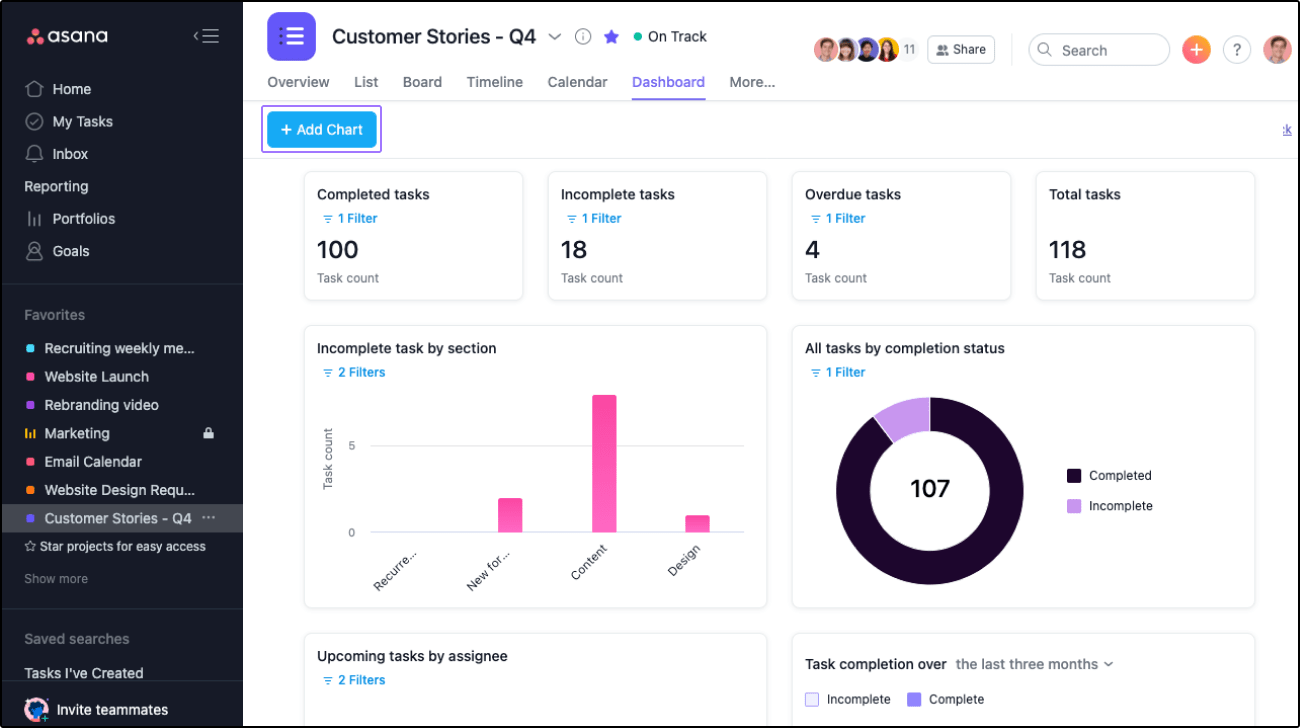
Best for smartphone users.
Asana is a comprehensive project management solution that can be effective for teams of all shapes and sizes. You can use it to improve efficiency, streamline workflows, and improve customer relationships through seamless collaboration.
With tools suitable for task management, agile team management, customer request tracking, and more, it enables you to stay on top of all tasks and processes with the utmost ease.
✨ Features
Some of the key features you’ll enjoy with Asana include:
- AI-powered Asana intelligence;
- Time tracking;
- Reporting;
- Automatic updates;
- Mobile and desktop apps.
**➕
Pros**
- Cross-team process automation;
- Comprehensive integration options;
- Excellent mobile and desktop apps.
➖ Cons
- More expensive than similar solutions;
- Limited assignments.
💸 Pricing
If you’re interested in Asana, you’ll have the option to join one of its three plans:
- Basic – free for individuals;
- Premium – $10.99 per user/per month;
- Business – $24.99 per user/per month.
As a general rule of thumb, the Premium plan offers the best price-to-quality ratio.
10. ProofHub
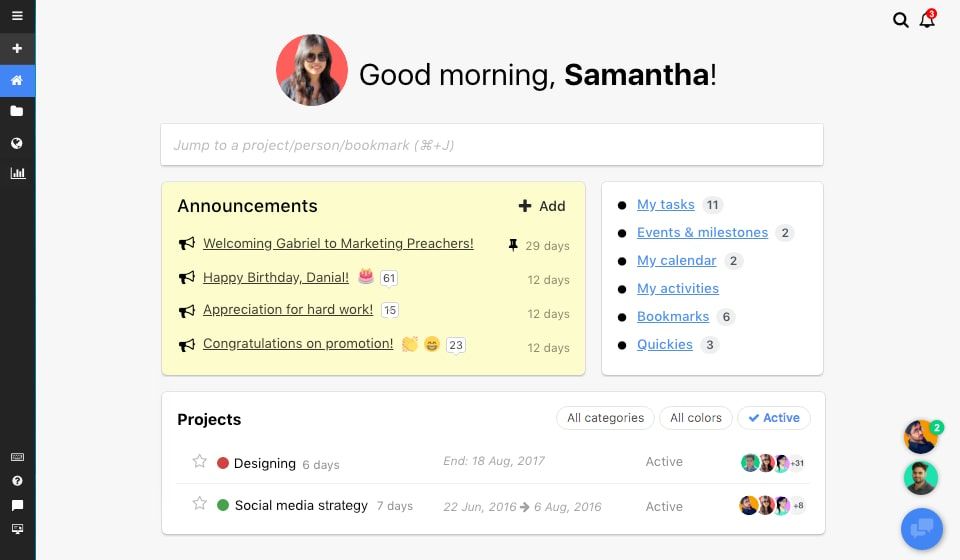
Best for remote teams.
ProofHub is one of the top solutions for remote teams looking to improve collaboration among themselves and their clients. It has diverse communication features designed to make remote collaboration as easy and streamlined as that in person.
You can use it to stay on top of your customer list, create group and private channels, share valuable account insights, and more.
✨ Features
Some of its top features include:
- One-on-one and group chats;
- Customizable forms;
- File proofreading and review;
- Personalized announcements;
- Events and milestones.
**➕
Pros**
- No contracts – you can cancel at any time;
- Automatic daily reminders;
- Easy setup.
➖ Cons
- Limited integrations;
- Only up to 100GB of storage.
💸 Pricing
Unlike similar solutions, ProofHub has no annual contracts you’ll need to abide by. There are only two pricing plans, and you can easily cancel at any time:
- Essential – $45 per month (unlimited users);
- Ultimate Control – $89 per month (unlimited users).
The Ultimate Control gives you access to all the advanced features you’ll need for a seamless experience.
11. Clinked

Best for teams in financial, legal, or healthcare industries.
Clinked is one of the most popular client collaboration tools for those in the financial, legal, or healthcare industries. It has advanced security features to ensure your and your clients’ data is always kept safe and sound.
Depending on your needs, you can even use Clinked to create a custom client portal that perfectly suits your unique needs and preferences.
✨ Features
With Clinked, you’ll gain access to features such as:
- Virtual data room;
- Secure data collection;
- Sales management;
- Embedded dashboards;
- Audit trail.
**➕
Pros**
- End-to-end encryption;
- Integrations with over 3,000 apps;
- White-label mobile app.
➖ Cons
- Steep learning curve;
- More expensive compared to similar solutions.
💸 Pricing
There are four pricing plans you can choose from when joining Clinked:
- Lite – $95 per month (100 members);
- Standard – $239 per month;
- Premium – $479 per month;
- Enterprise – custom pricing.
As mentioned, you can also create a fully customized client portal with Clinked, with its price depending entirely on your unique needs.
12. Wrike

Best for marketing agencies.
Last but certainly not least, Wrike is a powerful solution for project management and team and client collaboration. As a general rule of thumb, it’s the most popular solution for those who have their own marketing agency or offer professional services.
It offers advanced analytics, project tracking, and collaboration options, making it an excellent choice for larger teams and businesses.
✨ Features
Some of the top features you could expect with Wrike include:
- Automated workflows;
- Kanban boards;
- Smart approval;
- Cross-tagging;
- Project resource planning.
**➕
Pros**
- Customizable request forms;
- Advanced reporting;
- Versatile and flexible.
➖ Cons
- Lacks budgeting tools;
- Not suitable for smaller teams.
💸 Pricing
To take advantage of everything that Wrike has to offer, you’ll need to sign up for one of its five plans:
- Free – unlimited users;
- Team – $9.80 per user/per month;
- Business – $24.80 per user/per month;
- Enterprise – custom pricing;
- Pinnacle – custom pricing.
The Pinnacle plan is designed for teams with complex and unique needs and can be almost fully customized to suit you perfectly.
Top 5 customer collaboration platforms compared
| Collaboration Tool | Free | Price | Collaboration Features |
|---|---|---|---|
| Ayanza | ✅ | Free – up to 5 users; Pro – $6 per user/per month; Ultra – $15 per user/per month; Enterprise – custom pricing. | Real-time collaboration, commenting, notes, file sharing, chat, team spaces, etc. |
| Trello | ✅ | Free – for the whole team; Standard – $5 per user/per month; Premium – $10 per user/per month; Enterprise – $17.50 per user/per month. | Activity log, cards, checklists, calendar, attachment permissions, etc. |
| ProofHub | ❌ | Essential – $45 per month; Ultimate Control – $89 per month. | Discussion topics, topic privacy levels, file sharing, comments, mentions, etc. |
| Clinked | ❌ | Lite – $95 per month; Standard – $239 per month; Premium – $479 per month; Enterprise – custom pricing. | File requests, group chats, mobile push notifications, content following, etc. |
| Asana | ✅ | Basic – free for individuals; Premium – $10.99 per user/per month; Business – $24.99 per user/per month | Messages, calendar views, milestones, reporting, etc. |
What to ask the provider on a demo call about customer collaboration software
As you might have noticed, most customer collaboration tools prefer offering insightful demos rather than free trials. After all, a demo will introduce you to the software’s features and capabilities much better than a short trial ever could.
However, even though demos can be very comprehensive, you’ll likely need additional information before committing to a solution.
To ensure you’re well-informed, you should keep the following questions in mind during your demos:
- What prior experience do you have working with businesses in my industry?
- Can you tell me about the work you’ve done for other businesses in my industry?
- Do you have any reports or analytics to help me track my growth with your solutions?
- What security features does your solution offer?
- What are your payment options, and what currencies do you accept?
- How much technical knowledge do I and my clients need to use your solutions?
- Do you offer support outside traditional office hours?
- What benefits does your solution offer compared to your competitors?
- How can I cancel my subscription to your services should I need to?
- How can I upgrade or downgrade my subscription plan?
Of course, these are just some of the questions you should be interested in. It’s in your best interest to take notes throughout the demo and make sure that you clarify any points that concern you before the demo is over.
Efficient implementation of client collaboration software
Introducing new software to your teams and clients is rarely easy. You’ll likely encounter numerous obstacles that might even make you question whether you’ve made the right decision.
However, all it takes is a bit of patience and prior planning to get the most out of your new client collaboration tools.
To ensure that the implementation process goes smoothly, you’ll want to:
- Transition slowly (slowly fading out any existing collaboration options you have in place);
- Explain why you’re introducing a new solution;
- Highlight the benefits to your teams and clients;
- Specify how new solutions will be used;
- Create comprehensive training and onboarding resources.
Depending on your industry, you might encounter some internal and external resistance when introducing new solutions. The key is keeping your communications clear and concise and ensuring that everyone is always well-informed.
Conclusion
Client collaboration tools can be transformative in any industry and niche. Helping you increase transparency, simplify project planning, save time and money, and boost customer retention, they are a necessity for any business that wants to remain competitive.
FAQ
Can client collaboration software help
improve communication
with remote clients or team members?
Yes. Client collaboration software is designed with many communication features that simplify and improve communication with remote clients and team members. Most solutions are web/cloud-based, and many even come with handy mobile apps that enable seamless remote communication.
Does customer collaboration software offer
real-time collaboration
features?
Whether customer collaboration software offers real-time collaboration features depends on the tool you’re using. Most solutions like Ayanza will offer real-time collaboration, live chat, messaging, and more to help you stay connected with your clients at all times.
Are there
customizable options
available for customer collaboration tools?
Most customer collaboration tools will have customizable features and capabilities that enable you to maximize their effectiveness. However, the specifics will vary from one tool to the next, so it’s best to research a tool thoroughly before you start using it.
What is the
learning curve
for using a customer collaboration platform?
How steep the learning curve is with a customer collaboration platform will depend heavily on the platform in question. Ayanza, for instance, is known for its intuitive interface and easy-to-use features, while ClickUp, on the other hand, tends to be more complex for new users.
What is the
cost
associated with implementing a client collaboration platform?
Some client collaboration platforms will have quite generous free versions that enable you to communicate with all your clients with the utmost ease. Others will require a hefty investment of hundreds of dollars per user, depending on the subscription plan you choose.
On average, mid-range subscription plans will cost you around $15 to $50 per user per month.
Are there any
limitations or potential drawbacks
to using client collaboration software?
The only major potential risk is data security. You’ll need to ensure that any information exchanged between you and your clients remains protected at all times. When choosing your client collaboration software, make sure that it has extensive security features that will give you and your customers peace of mind.


